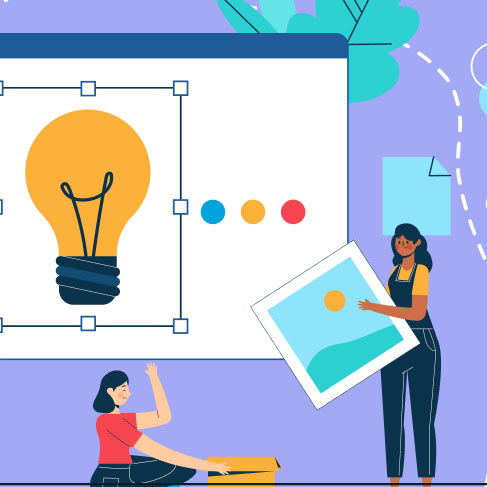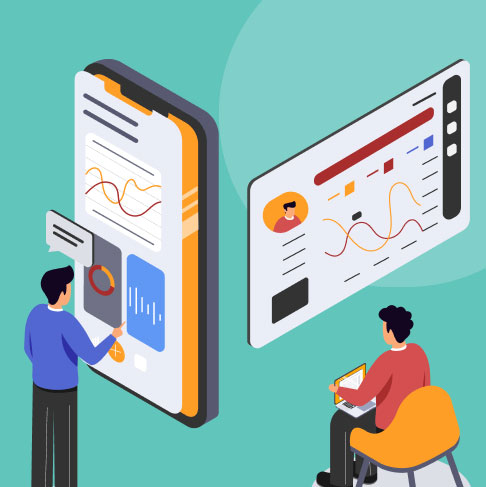The Significance of Visual Elements in Product Design
February 3, 2023 | Read Time : 3 mins
Table of Contents
What are visual elements?
Visual design aims to improve the aesthetic appeal and effectiveness of a design/product by using appropriate imagery, typography, spacing, layout, and coloring.
Visual elements such as line, shape, color, texture, and pattern are the essential building blocks of every sort of visual communication.
People tend to judge a book by its cover. This applies to many things in the world, including digital experiences. The appearance of our items influences how our users experience them.

Importance of visual elements
The aesthetic-usability effect demonstrates that individuals are more likely to ignore some usability flaws in aesthetically beautiful products. Visual design is critical in producing items with high aesthetic value.
Let’s find out how visual elements influence user behavior and product experience.
Improves data perception
Visual perception is one of the most efficient and rapid methods of transmitting information to the brain.
According to Kahneman, author of Thinking Fast and Slow and recipient of the Nobel Prize in Economics, this occurs because our thoughts are divided into two systems. The first, System 1, works extraordinarily quickly, naturally, intuitively, instinctively, and with little effort. System 2 controls our attention to difficult mental activities such as complex mathematics or anything else that requires much effort and focus.
Remember Information for long time
Humans have an impressive ability to remember visuals even after they have been exposed to them only once. As a result, incorporating visual stimuli in our product flow greatly enhances user experience.
It evokes joy
When our minds acquire a rapid understanding as a result of a minor mental exertion, our bodies respond positively, evoking a sense of joy.
It directs attention
Visual components can help with overall interface navigation. Fonts, whitespace, CTAs, typography, and images may act as visual dividers between sections, allowing users to perceive what’s happening in front of them.
Furthermore, eye-tracking research shows that readers pay more attention to visually rich content. They spend more time gazing at visuals than reading the text when they are relevant.
Makes it universal
Finally, icons, colors, images, and other visual components in the interface can improve the accessibility of an app or website, particularly when used by people from different countries.
As a result, we can conclude that the usage of iconography increases overall understanding. Furthermore, visuals extend the boundaries of vision for individuals who have difficulty reading or are unable to read due to text recognition problems such as dyslexia.
How can visual designers improve user experience?
A good visual design can improve a product’s overall user experience by making people feel better about it. Here’s how visual designers can use their skills to create better UX.
- Aim for consistency in design: Inconsistency may quickly make even the most attractive design useless. Inconsistency requires customers to invest more time and effort in learning how to use the product, and irrespective of how beautiful the product is, it may rapidly turn unattractive for users if they become confused along the way.
That is why visual design is more than just making the UI look beautiful; it is also about creating and maintaining a product’s overall aesthetics. To do this, visual designers build a style guide and set guidelines for applying styles to layouts. - Clear visual hierarchy: The visual hierarchy is how we display and draw attention to elements on the screen. A clear visual hierarchy assists in conveying information and focuses user attention on important actions. This guideline is especially important in web design because your competitors’ websites are simply a click away. Users start leaving and never return if they cannot locate what they are looking for on your website.
- Testing visual concepts with the user: Humans are visual beings. The vast majority of us absorb information based on what we see. And we respond significantly to visuals. As a result, the images and colors you choose for your visual design might impact how much your users enjoy your product. However, do not just assume that people will enjoy your design. Test it with them and track your progress depending on user behavior. The sooner you start testing, the more confident you’ll be in your design decisions.
It only takes a few seconds for website visitors to develop a first impression, and most of the time, that impression is based on what they observe. Naturally, people will assess a product from all angles once they begin engaging with it. Putting time and effort into the visual design will contribute in making a good first impression on your users/visitors.






